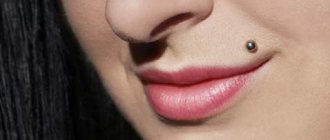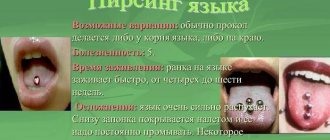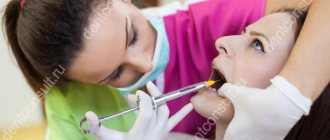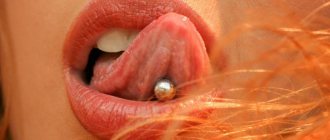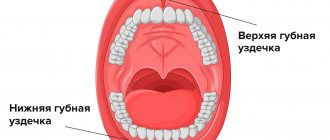The tradition of decorating the area above the upper lip with a “mole” has been around for centuries. And if in the 18th century they were made of velvet and attached with glue, then in the 20th century the fabric versions were replaced by the Monroe piercing, named after the famous beauty Marilyn Monroe. Other names: Madonna piercing or Crawford piercing have the same origin - all these movie and pop stars are owners of such attractive moles by nature. The difference is that the Monroe and Crawford piercings are done on the left side, and the Madonna piercings are done on the right.
Nowadays, Monroe piercing is no longer just the prerogative of girls - men also decorate themselves with metal moles. If you did not inherit such jewelry, piercing specialists will come to the rescue and quickly correct this “flaw.”
Lip piercing: what is it and cost
A similar lip piercing service can be obtained at any beauty salon for a fairly reasonable price.
Before making a final decision on the advisability of such manipulation with your face, it is worth understanding what piercing is, what types and places of punctures are considered as painless and safe as possible, and also how to choose the right jewelry for a “broken” lip so that it does not interfere with normal healing wounds after breaking the integrity of the skin.
Lip piercing means a piercing of the lower or upper lip, followed by attaching jewelry to the “pierced place.” Due to the absence of vital points, nerve endings, and large blood vessels in the areas of the body in question, such manipulation is considered as safe as possible.
Lip piercing, as statistics show, can be available to a person at any age and of any gender, as evidenced by various photos on the Internet depicting older people with tattoos and piercings. This procedure has no direct contraindications related to gender or age.
If necessary, for example, at the request of the employer, the earring can be easily and painlessly removed from the lip. Wearers of jewelry of this type also note that with a long “break” in wearing earrings, you can practically return your face to its original appearance, since the “punched” hole is 99% overgrown, leaving behind the smallest point at the place where the miniature metal structure is attached.
Angel bite
Angel bite (eng. angelbites) is a puncture on both sides of the upper lip.
Types of piercing
Lip piercing, photos of examples of which can be found in the vast majority of beauty salons, is traditionally classified into subtypes. In distinguishing between “piercings”, craftsmen base their decisions on the place chosen for attaching the earring, as well as the jewelry itself.
The most popular are:
- Snake bite. This procedure involves “creating” two symmetrical punctures located on both sides of the lip, most often the lower one. Such piercing is not chosen by every person who decides to decorate himself, due to the complexity and duration of the body decoration process under consideration.
- Monroe. This type of earring fastening has a telling name, specially created to evoke associations with the actress of the last century - Marilyn Monroe. The essence of this “parallel” is that the Monroe piercing is done above the upper lip, and precisely on the left, exactly where Marilyn Monroe had her famous birthmark. Decoration in this place adds tenderness and femininity to its wearer.
- Madonna. Lip piercing, for the most part similar in principle to the above-described “Monroe”, but differing solely in the placement of the decoration. So, if “Monroe” is decorated on the left side above the upper lip, then “Madonna” is placed on the right.
- "Dahlia". This type of piercing involves simultaneous piercing of holes for further fastening of earrings on both sides above the upper lip. In other words, the owner of the “Dahlia” possesses both the “Monroe” and the “Madonna” described above.
- "Jellyfish". This name for the procedure is traditionally used in the context of the localization of the “broken” area under the nasal septum, in the middle of the labial “philtrum”.
- "Bridle". The telling name, in this case, indicates the piercing of the frenulum of the tongue itself. Due to its invisibility, which is considered unacceptable for young people who want to stand out, this type of piercing has recently been losing its once high popularity.
Traditionally, the decoration is an earring - labret, located vertically or horizontally. This decoration is an accessory in the form of a small barbell with a ball at the end. Labret is rightfully considered one of the types of piercings that delivers a minimum of pain to the owner when it is inserted into a specially designed hole in the lip.
Given this fact, the use of various types of labret is most common among those for whom such a “puncture” will be the first. In the vast majority of cases, the metal “bar” is inserted in the direction from bottom to top.
Based on approximately the same complexity of the piercing process in all the cases described above, the price for them is also identical.
In top beauty salons or tattoo studios, a master will ask from 1000 to 2000 rubles for a lip piercing. The standard price already includes a preliminary consultation on caring for the piercing, possible complications, a “medical” earring and “punching” a hole in the lip area to place jewelry in it.
Criteria for choosing a salon and specialist
Doctors remind us that there is a high level of risk in any invasive procedures, so the choice of the person who will perform the puncture and the place where everything will happen must be approached responsibly. Firstly, consider only beauty salons or tattoo parlors - only here you have a chance to get all the conditions and a qualified specialist. Basic points:
- A good master is a person who has a document of completion of appropriate training and is certified by the Association of Professional Piercers. It is also important to have a medical book, and ideally the master should have a medical education.
- The salon where the piercer works must have a license authorizing the provision of cosmetology services and medical certificates.
Contraindications
Lip piercing, photos of which certainly impress people of all ages with their originality, have a number of serious contraindications, in particular:
- deviations revealed by a blood test associated with differences from generally accepted indicators of blood clotting;
- the presence of chronic diseases of any etymology, especially during relapses;
- increased body temperature or “jumps” in blood pressure;
- pregnancy;
- lactation period.
If you have at least one of the above “illnesses,” it is advisable to postpone or completely abandon the idea of piercing. Otherwise, the consequences for human health and life may be unpredictable and even require significant medical intervention.
Piercing contraindications
Studies carried out already in the 21st century showed that 30% of people who had piercings, especially on the face, experienced complications, some of which (about 1% of all cases) required hospitalization. For this reason, doctors advise paying close attention to medical contraindications so that the craving for beauty does not become fatal. It is not advisable to resort to this procedure:
- During activation of herpes.
- Diabetics.
- If you have skin diseases.
- Persons with poor blood clotting.
- When the body is fighting a cold or any viral/bacterial infection.
- Pregnant women (relative contraindication, should be discussed with your doctor).
- For congenital blood diseases.
Possible complications and consequences
Piercing is a process that grossly violates the integrity of the skin, which over time can lead to certain complications for its owner.
In addition to the obvious potential danger of infection when piercing a hole in the lip for an earring, common undesirable consequences also include:
- significant damage to tooth enamel, leading to increased sensitivity and, as a result, tooth destruction;
- the occurrence of allergic reactions, the initiator of which may be the material used in the production of jewelry, a non-sterile needle or a solution for disinfecting the puncture site;
- incorrect “fusion” of holes for earrings. Unfortunately, such a consequence is extremely common among “beginners” who pierce their lips and others. It is worth emphasizing that when faced with the described fact, only surgical intervention can correct the situation. Accordingly, it is necessary to carefully choose “your” master, who has extensive experience and a serious approach to business;
- damage to secondary nerve endings, resulting in particular in the “death” of receptors responsible for recognizing the temperature of a dish or even its taste.
What is dangerous about the pathology of the frenulum attachment?
Indications for frenuloplasty arise not because of doctors’ desire to correct an anatomical feature, but for compelling reasons that affect the health and beauty of the smile. A similar defect results in:
- to the formation of a diastema - an excess gap (gap) between the front incisors, which, moreover, tends to expand. A short frenulum is fixed too close to the edge of the alveolar process and pushes the teeth in different directions;
- the appearance of a gum pocket - a depression behind the gum due to its injury by the frenulum, where food debris begins to accumulate, tartar forms, and the exposed necks of the teeth suffer from increased sensitivity. Ultimately, this process can lead to periodontitis, loosening and loss of teeth;
- speech problems - with a short frenulum it is difficult to pronounce many consonants and some vowels (“o”, “u”);
- bite pathologies - due to improper closure, tooth enamel is erased, teeth grow in the wrong direction, oral hygiene, the quality of chewing food and the functioning of the entire gastrointestinal tract deteriorate, and at the same time, a short frenulum prevents the correct installation of the braces system;
- difficulties when performing prosthetics - a short frenulum does not allow the prosthesis to be firmly held in the mouth, and it may fall out while eating or talking;
- injury during individual oral hygiene and its deterioration in general.
Lip piercing site
Lip piercing, photos of which can be found in huge numbers on the Internet, can be localized not only directly in the specified area, but also in the nearby area of the face.
The most popular places for punctures among connoisseurs of the considered art of decorating the body are:
- Above the lips. In most cases, girls choose to pierce the area above the upper lip. This fact is due to the maximum painlessness and speed of the process, as well as the creation of a femininity effect by simulating a mole with metal jewelry.
- Upper lip. Upper lip piercing is considered the most optimal option for those who have not fully decided on the need to become its owner. Due to the good regenerative properties of the skin of the lips, a hole “punched” in this area heals without a trace if left for a long time without jewelry inserted into it.
- Underlip. Lower lip piercing is considered relatively painful and often involves two symmetrical holes. Considering the long duration of the process, as well as the presence of nerve endings in the area in question, the choice of lower lip piercing is made by people with a high pain threshold or those who are ready to make “any sacrifice” for the sake of their own concept of beauty.
- Labial frenulum (“Smile”). This type of piercing is losing its former popularity in the modern world. A labial frenulum piercing is considered “intimate”, since it can only be seen by the person to whom the owner of the piercing decides to demonstrate it. Despite the latest trends that require the maximum shocking appearance of young people, loyal “fans” of the “smiley” remain people whose official position does not allow them to wear earrings in remarkable places, in particular on the face.
There are things to think about
Yes, a pierced lip looks quite unusual. However, before you dare to take this step, you should pay attention to some nuances that, quite possibly, will make you change your mind or postpone going to the salon for an indefinite time:
- Medical indicators. Even simple rashes during a seasonal exacerbation of ARVI can become the No. 1 reason that does not allow getting a piercing under the lip. Eczema, diabetes, epilepsy, pregnancy and lactation, as well as allergies to metals - all of these are serious medical contraindications that prevent piercing. It is also better for girls during menstruation to refrain from going to the salon for a while.
- Appropriate dress code. Do not forget that piercing is a clear manifestation of informal style. If a girl or guy works in a reputable company where business negotiations are often required, piercing will make a negative impression on the interlocutor.
- Competent choice of master and salon. This is where it gets serious – this issue should be approached with special care. The lack of a license and certificate is a sign that this place should be avoided.
Interesting: Eyebrow piercing: how the piercing is done, types. Care and selection of decoration
Many people are shy in front of the salon door, fearing that the procedure will be painful. In fact, piercing the upper or lower lip is not as scary as it seems at first glance. If you evaluate the painful sensations during the process of creating a piercing, you can give 6 points out of a possible 10.
In addition, a lip piercing heals very quickly - the tissue in the mouth area is soft and thin, devoid of blood vessels and capillaries. This means that the experience of a professional master will allow you to quickly and efficiently complete the procedure.
Earrings and piercing jewelry
Having decided on the desired location for the lip piercing, the next important issue to be resolved is related to the choice of jewelry intended to be placed in the “punched” hole. Most types of piercings involve choosing a specific type of earring, but there are also situations where you have to base your decision solely on your own preferences.
In such cases, the “favorites” among decorations often become:
- labrets (the design implies the presence of a flat surface, traditionally located on the mucous side of the lip; a barbell; a decorative “cap”, which can be either an ordinary metal ball or rhinestones or diamonds);
- rods (they have an almost identical design with labrets, differing only in the presence of balls as “caps” on both sides, and not on one, as in the first case);
- spiral (outwardly it is a small fragment of a coil of a spring, often decorated with stones at both ends, due to their simultaneous fastening “in plain sight”);
- rings, including segment ones (used exclusively to decorate the internal cavity of the mouth, in particular the frenulum, due to the impossibility of attaching them, for example, above the upper lip. Using segment rings, the owner of the piercing has the opportunity to divide them into components (segments) to give even greater extraordinary appearance);
- “flies” or “microbananas” (represent a curved labret used by craftsmen when creating piercings in the “Monroe” or “Madonna” style);
- circulars (have an appearance similar to traditional rings, differing in the presence of threaded connections along the edges).
As can be seen from the types of piercing jewelry listed above, the use of a specific earring shape or mount must be carefully thought out and must be agreed upon with a competent piercer who has extensive experience in this field.
A competent specialist should be able to give practical advice on choosing the most suitable jewelry option , which subsequently will not cause pain to its owner while wearing it directly in the lip.
When to perform the operation?
It is best to perform the operation on children aged 5 to 8 years during the period when baby teeth are replaced by permanent teeth. The most appropriate moment is when the lateral incisors (“twos”) have not yet erupted, and the central ones have appeared by about a third. Plastic surgery will prevent the development of diastema and will help the incisors to take a central place.
The operation can be performed on both adolescents and adults. Plastic surgery of the frenulum of the upper lip in infants is performed only according to strict indications that affect the quality of the child’s nutrition.
In adulthood, surgery most likely will not solve the problem, but it will greatly facilitate the process of prosthetics.
Jewelry material
Lip piercings, photos of which are used as examples of the piercing artist’s own work, do not convey the existing qualitative difference between the materials used in the production of jewelry.
The safest and most affordable products are made from:
- gold;
- silver;
- become;
- black steel;
- titanium;
- black titanium
- bioplastic;
- PTFE;
- organic materials, in particular wood;
- bioflex.
Which decoration is better to put first?
As the first jewelry inserted into the “freshly pierced” hole, experienced piercers recommend using a labret with an extended barbell made of a medical alloy. The medical alloy minimizes the risk of infection and further development of infection at the site where the integrity of the skin is broken, and will also reduce pain after the procedure itself.
The elongated rod of the “primary labret,” in turn, will ensure comfortable wearing of the jewelry in case of existing swelling , under favorable conditions for wound healing, which persists for several days after the immediate “breaking through” of the lip.
Using other types of earrings for a “fresh” piercing can provoke painful sensations during skin regeneration, and also create a risk of damage to the “hole” itself, due to the possibility of touching, pulling, or catching on an earring with a “complex” design.
Types of piercing
There are several methods of ear piercing. The procedure can be performed using a catheter, a gun, or a disposable system. In addition to the lobe, cartilage piercings are often performed:
- helix – the outer rim of the ear (through the helix);
- scapha - navicular fossa (through the base of the helix);
- The tragus is a small cartilage above the opening of the external auditory canal.
There are also other ear piercing options:
- conch – lower cavity of the shell;
- arm – lower leg of the antihelix;
- dait – the lower inner part of the helix, cartilage adjacent to the face;
- tragus - privocozel, a section of cartilage above the lobe;
- snug is a vertical projection of the antihelix.
Main stages of the procedure
The lip piercing procedure is relatively short and does not require special preparation, with the exception of the basic rules prohibiting the consumption of alcohol on the eve and on the day of the “creation” of the piercing.
Photo of making a lip piercing.
The basic stages of the lip decoration process are:
- Reducing salivation by “plugging” large salivary glands located under the tongue with a cotton pad or a special “suction” device.
- Treatment of the future piercing site. Hydrogen peroxide or Chlorhexidine is traditionally used as a disinfectant.
- Preparation of lips. Depending on the area being pierced, the upper lip is strongly pulled upward to pierce the frenulum, or with the help of special forceps it is “fixed” in a position convenient for the master.
- Puncture. Using a sterile catheter or a thin long needle from a traditional syringe, a straight line is inserted into the lip, piercing it through and resulting in a hole for future attachment of jewelry.
- “Installation” of the earrings. Having made sure that the puncture process was performed correctly, and also that the resulting hole is through, the master inserts a pre-disinfected rod into the lip, securing it on both sides.
- Final treatment of the oral cavity. At the final stage of “creating” the piercing, experienced craftsmen “rinse” the patient’s mouth with “Miramistin” and also generously “moisten” the place where the jewelry is attached with hydrogen peroxide.
How to care for a wound
Purchasing an antiseptic (mainly Chlorhexidine, 3% hydrogen peroxide) is the first step, which is advisable to complete before booking a lip piercing. No matter how well the master does his job, for about a month after the procedure he will have to treat the puncture site with an antiseptic every day to prevent infection. Additionally, it is important to follow a few more rules:
- Do not remove the earring, even for processing.
- Take food mainly in liquid form, exclude hot, pickled, and spicy foods.
- Do not wet the jewelry for 3-4 days after the procedure (excluding treatment with an antiseptic).
- Rinse your mouth after each meal with saline solution or Chlorhexidine (mixed with water).
- Women should not wear lipstick.
- Do not drink alcohol or smoke for four weeks.
Caring for your lip piercing site
Upon completion of the above process, the client is traditionally given recommendations for further care of the piercing, which are necessary to follow without fail over the next few weeks.
During the first two weeks, the owner of a lip decoration should not forget about:
- Rinsing the mouth with saline or another substance recommended by the specialist to “cleanse” a fresh wound. During this action, it is important to carefully remove “mucous crusts” and particles of “dead” skin from the primary labret, which interfere with the rapid healing of the “broken” area.
- Treat the puncture on the outside of the lip with Miramistin or hydrogen peroxide 2-3 times a day.
After 2 weeks from the date of lip piercing, it is advisable to:
- Continue “internal” washing of the piercing 1-2 times a day, replacing the saline solution with soapy water.
- After the physiological swelling of the lip disappears, visit a piercer to replace the primary jewelry with the desired one, which has standard design sizes.
Even after the completion of the initial “healing” stage of the “pierced” piercing site, frequent replacement of earrings or their constant touching is highly discouraged.
If the jewelry placed in the recently restored skin is too mobile, its owner risks damaging the internal integrity of the mucous membrane, thereby provoking a repeat of the process of “healing” of the wound.
Why get a piercing
It is believed that when people first meet, they look at their eyes and lips.
Therefore, lips are one of the most important parts of the face; their condition and appearance greatly influence the overall attractiveness. Therefore, lip piercing allows you to emphasize their graceful shape and highlight other positive features of this part of the face. In any case, an unusual decoration on the lip will attract attention and improve your appearance. Historically, piercing is one of the oldest ways to decorate the body. Lip earrings were used by representatives of many nationalities; they made it possible to demonstrate belonging to a certain clan and emphasize the desired character traits. Even now, many tribes in Africa and Australia pierce their lips and use various decorations.
In the modern world, piercing has lost its traditional meaning and has become a tribute to fashion and a way to emphasize one’s beauty and unique style.
Does it hurt to get your lip pierced?
In the vast majority of cases, a lip piercing is comparable in pain to drawing blood from a finger , and “piercing” the frenulum is considered painless.
However, for the most part, the sensations during the described process depend on the pain threshold and sensitivity of the “daredevil” skin. People who are afraid of pain when “creating” a piercing should remember that the artist can numb the site of a potential hole with special anesthetic drugs.
How to pierce your lip at home
The number of masters performing piercings (not ears, but other parts of the body) was not so large 10 years ago, so most people who wanted to stand out tried to pierce themselves. However, a home procedure without professional supervision is painful and unsafe. This is done with special tools like this:
- Disinfect the instrument, jewelry and puncture area with medical alcohol.
- Remove excess moisture from the puncture area with clean gauze.
- Puncture the muscle tissue from the inside.
- With new force, push the tool further so that the tip comes out.
- Place the decoration along the tool mark into the hole created.
Lip piercing at home is easy to do, but keep in mind that you may hit the wrong spot, which will cause too long healing, scarring, and inflammation. Additionally, you should remember about the sterility of the instruments and their correct choice: no sewing needles - only a special medical catheter. The movements should be smooth, ideally the procedure should be carried out by a stranger - a mother, a friend.
How long does it take for a pierced lip to heal?
Complete healing of the wound occurs approximately 3 - 4 weeks after the procedure. This time is enough to relieve swelling of the “broken” area, “tighten” the damaged mucosa, and also “accept” the foreign object (in this case, the primary labret) by the body.
There are cases when, due to certain circumstances, healing was delayed until the infection that got inside the hole was eliminated, for example, with street dust or due to non-compliance with the recommendations for the initial treatment of the lip puncture site.
However, in any of the listed cases, skin regeneration after the “creation” of the piercing did not take more than 1.5 months and did not require special energy expenditure on the part of its owner.
Considering the above information, lip piercing cannot be considered a hazardous procedure. By following basic safety rules, as well as recommendations for caring for the piercing site, the owner of the jewelry will be able to join the ranks of happy owners of piercings depicted in numerous photos on the Internet and thematic glossy magazines.
Preparing for piercing
A few days before the procedure it is recommended:
- Treat the future puncture site with soothing ointments if there are areas of inflammation or irritation;
- Do not drink alcoholic beverages;
- Do not take aspirin and vitamin E, naproxen and ibuprofen, or any antibiotics. If you are sick, it is better to postpone the procedure until complete recovery;
- Exclude coffee and green tea, energy drinks, garlic and ginseng from the menu;
- Add vitamin K to your diet - dishes with cabbage, pumpkin, olive oil, bananas, etc.;
- Brush your teeth especially carefully, or even get a professional cleaning from your dentist.




